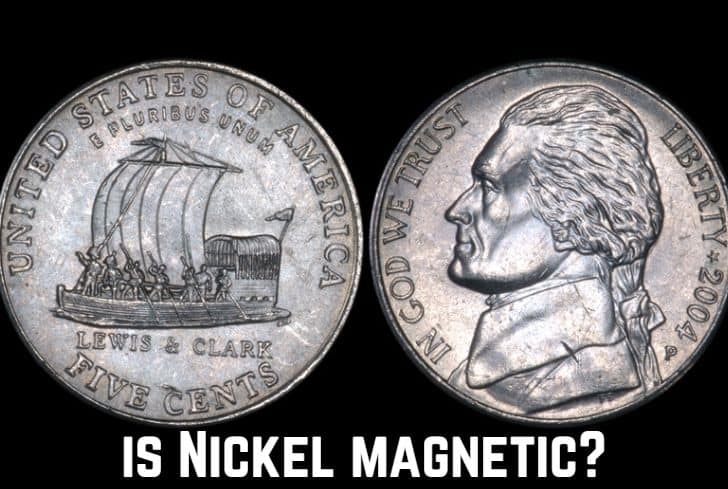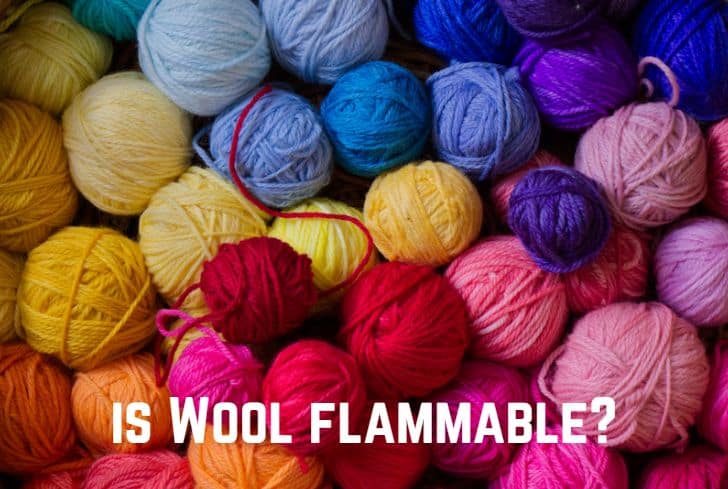Is Nickel Magnetic? (Yes…)

Nickel (Ni) is a chemical element with the atomic number 28, and it is a silvery white metal. Nickel was named after “Old Nick”, a mischievous sprite from German Mythology; miners found an ore resembling copper but when they were unable to obtain any copper from it, they blamed Old Nick for plaguing the stone and named it Kupfernickel.
Have you ever wondered if Nickel is magnetic? In this article, we are going to discuss just that. We will begin by looking at the properties and uses of nickel. Then we will talk about its magnetic characteristics. Finally, we will talk about recycling nickel.
Read: Is Wood Magnetic?
Is Nickel Magnetic?
Yes, nickel is magnetic. It is a ferromagnetic material, so it will be strongly attracted to magnets. This is because nickel has unpaired electrons in its outer shell, which spin in the same direction and cause the element to become magnetic.
Let us first try to learn what magnetism is. Magnetism is a force caused by the motion of electric charges. Every substance is made up of atoms. These atoms have electrons (particles that carry an electric charge) that circle the atom’s centre, called the nucleus.
In most substances, equal numbers of electrons spin in opposite directions. This cancels out their magnetism, and they are not attracted to a magnetic field. These include things like paper, cloth, wood, etc., and they are called diamagnetic.
However, in some substances like iron, the electrons spin in the same direction. This allows their magnetic fields to combine, and it produces a magnetic field extending beyond the atoms. These objects are strongly attracted to magnets and are called ferromagnetic.
Nickel is one of the four elements (along with iron, cobalt, and gadolinium) that are ferromagnetic at room temperature. However, Nickel has a Curie temperature of 355 °C (671 °F). This means that above this temperature, nickel becomes non-magnetic.
Properties of Nickel
These are the properties of Nickel
- Appearance & Structure: Nickel is a silvery white metal with a slight golden tinge, and it is lustrous. Nickel’s unit cell is a face-centred cube having the lattice parameter of 0.352 nm.
- Ductile, Malleable, Conductive: Nickel is a tough metal, even harder than iron. But at the same time, it is quite ductile and malleable, meaning that it can be drawn out into thin wires and also be hammered into shape without cracking. Nickel is a great conductor of both electricity and heat.
- Chemical Behaviour: Nickel is a transition metal that belongs to Group 10 of the periodic table. Pure nickel is chemically reactive but large pieces are slow to react with air because nickel oxide forms on the surface, which acts as a passivation surface and also prevents corrosion. Nickel is resistant to the action of alkalies, but dissolves easily in dilute mineral acids.
- Melting & Boiling Point: Nickel has a melting point of 1728K (1455 °C, 2651 °F) and a boiling point of 3003 K (2730 °C, 4946 °F). Besides these, another property that is important for nickel is the Curie temperature. It is the temperature above which some metals lose their magnetic properties. Nickel’s Curie temperature is 355 °C (671 °F).
- Occurrence: Nickel is twice as abundant as copper and constitutes 0.007% of Earth’s crust. It is most commonly found in sulfur and iron in pentlandite. It is also found in iron meteorites in the form of alloys (kamacite and taenite). Earth’s inner and outer cores are believed to be made up of an iron-nickel mixture. China is the largest producer of nickel, while Russia, Canada, and Australia also contribute.
Uses of Nickel
These are the uses of nickel:
- About 68% of the world’s nickel is used in making stainless steel.
- Nickel is combined with copper to make corrosion-resistant alloys, and it is also mixed with chromium to create heat-resistant alloys. Nickel is so resistant that it can even resist corrosion by seawater, which is why it is used in propellor shafts of boats.
- Nickel is used in rechargeable batteries, such as those of Electric Vehicles.
- The metal is also widely used to make coins, although nickel-plated objects can sometimes cause nickel allergy.
- Nickel also has a range of chemical manufacturing uses. It acts as a catalyst for hydrogenation, cathodes for rechargeable batteries, and metal surface treatments.
In nature, nickel is an essential nutrient for microorganisms and many plants.
Why is Nickel Ferromagnetic?
Nickel is ferromagnetic because it has unpaired electrons in its outer shell. These electrons are arranged in such a way that they spin in the same direction, which creates a strong magnetic field. This magnetic field is what makes nickel ferromagnetic.
Magnetism is a force caused by the motion of electric charges. Every substance is made up of electrons (particles that carry electric charges), which circle the nucleus like spinning tops. Their movement generates an electric current, making each electron act like a microscopic magnet.
In most substances like paper or wood, an equal number of electrons spin in opposite directions, which cancels out their magnetism, and they are weakly magnetic. However, in substances like iron or nickel, the electrons spin in the same direction. This makes the atoms strongly magnetic, and they are known as ferromagnetic.
Nickel has a Curie temperature of 355 °C (671 °F), meaning that above this temperature, it loses its magnetic properties. This happens because the high temperature disrupts the atomic arrangement of the metal.
Above the Curie temperature, the atoms no longer align in the same direction to reinforce each other. Hence, only a weak kind of general magnetism (paramagnetism) remains. When nickel is cooled below the Curie point, the atoms once again realign themselves in the same direction, and ferromagnetism returns.
Read: Is 14k Gold Magnetic?
Magnetic Susceptibility of Nickel
The magnetic susceptibility of nickel is quite high because its electrons spin in the same direction, reinforcing each other’s magnetic field and making nickel ferromagnetic. However, the magnetic susceptibility of nickel reduces when the temperature increases above the Curie temperature.
Magnetic susceptibility is the measure of how much a material will become magnetized in an applied magnetic field. Nickel, due to the arrangement of its atoms, is a ferromagnetic material, meaning that it is strongly attracted to a magnet.
However, Nickel has a Curie temperature of 355 °C (671 °F). When the temperature rises above this, the atomic structure of Nickel changes—its electrons no longer spin in the same direction and it effectively loses its magnetic properties.
Nickel then acquires a weak kind of general magnetism called paramagnetism. Above the Curie temperature, increases in temperature keep reducing the paramagnetism further.
Is Nickel More Magnetic Than Iron?
No, nickel is not more magnetic than iron. When placed in the same magnetic field, iron will feel the strongest magnetic force, followed by cobalt and nickel.
Nickel is used in Alnico magnets (consisting of aluminium, nickel, and cobalt). These magnets are weaker than iron-based magnets, although they are stronger than rare-earth magnets.
Check out this video by Brainiac75 to see the comparative tests of magnetism between iron, nickel, and other metals.
Is Nickel a Good Conductor of Electricity?
Yes, nickel is a good conductor of both electricity and heat. Nickel, like most metals, is a good conductor because it has loosely bound valence electrons, which are free to move across and transport the electric charge.
The atomic number of nickel is 28, and its electronic configuration is 1s22s22p63s23p63d84s2. This indicates that the 3d orbital of nickel is not filled, and it has two unpaired electrons.
These loosely bound electrons can move across the material. When electricity is applied to nickel, these electrons move in a specific direction from the negative to the positive side of the supply, which is what conducts electricity.
Nickel has an electrical conductivity of 14.3 x 106 Siemens per meter. Because of nickel’s ductile nature, it can be used to make wires. Moreover, it can resist extreme chemical corrosion (as it forms nickel oxide), especially in aqueous and high-temperature environments. Nickel is also used in other electrical appliances such as rechargeable batteries of Electric Vehicles.
Can Nickel be Recycled?
Yes. Nickel is fully recyclable, like many other metals. It can be recycled over and over again without any loss of quality, which makes it ideal for the circular economy model. Recycling metals is good for both the environment and the industry.
Recycling is a crucial part of the metal industry. Today, we might perceive it as an environmental issue, but it has existed for many years as a profitable economic enterprise. Around the world, the entire process of recycling (gathering, transporting, etc.) scrap metal employs more people and generates more value than the mining & refining of ores.
Most nickel recycling is linked to stainless steel. Nickel-containing stainless steel scrap and nickel from recycled batteries are recycled into nickel-containing stainless steel.
Read: Is Gallium Magnetic?
Conclusion
In this article, we have looked at the magnetism of Nickel. Nickel has unpaired electrons in its valence shells, which spin in the same direction, reinforcing their magnetic fields. Therefore, nickel is a ferromagnetic material, which is strongly attracted to magnets. We looked at the properties, uses, and magnetic nature of Nickel. Finally, we discussed its recyclability.






